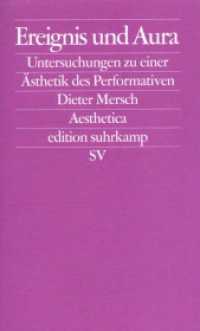- ホーム
- > 洋書
- > 英文書
- > Science / Mathematics
Full Description
Capillary electrophoresis combines the analytical separation technique of classical electrophoresis with the instrumental potential of modern chromatographic detection and automation. This book provides a practical introduction to capillary electrophoresis separation techniques. Particular value is placed on developing and optimizing a separation. Insofar as possible, Instructive examples were selected for the explanation of these processes, without recourse to mathematical details. This short introduction will facilitate the beginners entry and use of this efficient methodology.
Contents
1 Introduction.- 2 Principles of Capillary Electrophoresis.- 3 Theoretical Foundations and Their Influence on the Analytical Results.- 3.1 Electrophoretic Migration.- 3.2 Conductivity.- 3.3 Electroosmotic Flow.- 3.4 Band Broadening.- 3.4.1 Efficiency losses through diffusion.- 3.4.2 Efficiency loss through temperature effects.- 3.4.3 Loss in efficiency through electrodispersion.- 3.4.4 Efficiency losses through wall adsorption.- 3.4.5 Efficiency losses through overloading of the separation system.- 3.4.6 Efficiency losses through superimposition of flow profiles.- 3.4.7 Summary.- 4 Instrumentation.- 4.1 Power Supply.- 4.2 Capillaries.- 4.3 Sample Introduction.- 4.3.1 Pressure injection.- 4.3.2 Hydrostatic injection.- 4.3.3 Electrokinetic injection.- 4.3.4 Sample-split systems.- 4.3.5 Enrichment effects in sample introduction: sample stacking.- 4.4 Thermostating.- 4.5 Detection.- 4.5.1 UV detection.- 4.5.2 Fluorescence detection.- 4.5.3 Conductivity detection.- 4.5.4 Other detection methods.- 4.5.5 Derivatization reactions.- 4.6 Special Problems of Quantitative Analysis in CE.- 5 Capillary Zone Electrophoresis (CZE).- 5.1 Principles of Optimization in CZE.- 5.1.1 Effect of pH.- 5.1.2 Effect of buffer concentration.- 5.1.3 Buffer selection.- 5.1.4 Applications.- 5.2 Indirect Detection Methods in CE.- 5.2.1 Principles of indirect detection techniques.- 5.2.2 Separation of cations with indirect UV detection.- 5.2.3 Separation of anions with indirect UV detection.- 5.2.4 Analysis of cations and anions with indirect fluorescence detection.- 5.3 Capillary Zone Electrophoresis of Proteins.- 5.3.1 Separations in uncoated capillaries.- 5.3.1.1 Selection of the pH.- 5.3.1.2 Addition of salts to the buffer.- 5.3.1.3 Use of buffer additives for the separation of proteins.- 5.3.1.4 Dynamic coating of capillaries.- 5.3.2 Protein separations with surface-modified capillaries.- 5.3.2.1 Coatings for capillary electrophoresis.- 5.3.3 Overview of important chemical coatings for protein separation.- 5.3.3.1 Conventional coatings.- 5.3.3.2 Polymeric coatings.- 5.3.4 Summary.- 6 Micellar Electrokinetic Chromatography (MEKC).- 6.1 Fundamentals of MEKC.- 6.2 Optimization of Resolution.- 6.3 Selection of the Detergent.- 6.4 Separations by MEKC.- 7 Separation of Enantiomers by CE.- 7.1 Enantiomeric Separations with Cyclodextrins as Chiral Selectors.- 7.1.1 Neutral cyclodextrins.- 7.1.2 Ionic cyclodextrins.- 7.2 Other Separation Systems.- 8 Capillary Gel Electrophoresis (CGE).- 8.1 Acrylamide-based Gels.- 8.1.1 Preparation and manipulation of gel-filled capillaries.- 8.1.2 Crosslinked Polyacrylamide gels.- 8.1.3 Linear Polyacrylamide gels (LPA).- 8.1.3.1 Separation of DNA fragments with LPA.- 8.1.3.2 SDS PAGE (Polyacrylamide gel electrophoresis) of proteins.- 8.2 Polysaccharide-based Gels and other Polymers.- 8.3 Migration Models of Biopolymers in Polymer Solutions.- 9 Isoelectric Focusing in Capillaries (CIEF).- 10 Other Separation Techniques in CE.- 10.1 Isotachophoresis (ITP).- 10.2 Electrochromatography (EC).- 11 A Troubleshooting Guide to CE.- 11.1 Determination of the Problem Source.- Test 1: Recording a breakthrough curve under flushing pressure.- Test 2: Recording a breakthrough curve with the injection pressure.- Test 3: Checking the potental source.- 11.2 Scenarios of Problems: "What to do if...".- 12 Literature Index.- 12.1 Literature Cited.- 12.2 Additional Literature Sources.- 13 Acknowledgement.







